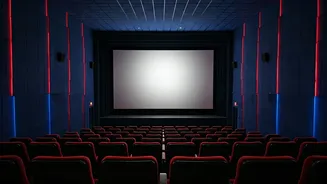Selective Openings Strategy
PVR Inox's strategic adaptation of being selective about cinema openings highlights a significant shift in business operations. This measured approach
may be a reaction to the volatile financial market in India, impacting the company's revenue streams. The decision-making process is now much more calculated than it was previously. The need to optimize revenue, manage risks, and ensure profitability appears to be a crucial driving force. This approach indicates a more cautious stance, emphasizing financial stability and a focused investment strategy. This approach represents a broader adjustment to the changing entertainment landscape in India, where consumer choices and spending habits are constantly in flux. It shows a commitment to navigating challenges and achieving long-term sustainability.
Market Dynamics' Influence
Market dynamics significantly influence PVR Inox’s business strategy. Factors such as stock market performance, with insights from BSE and NSE data, impact financial decisions and investment strategies. The company likely considers trends like top gainers and losers in both BSE and NSE, which indirectly shape its financial outlook. Data like the performance of IPOs, the rates of diesel, silver, gold, and petrol also play a role. These metrics, alongside Reliance Retail's quarterly profit jumps, provide context for consumer spending and industry health, guiding decisions about new openings and operational choices. The constant fluctuations in the market, including the performance of various indices, the rise in Bank of India profits, and the impact of government policies like GST cuts, all affect the company's strategic planning and actions.
Focus on Profitability
Profitability is the primary goal driving the company's selective approach to cinema openings. This emphasis aims to improve financial health and generate sustainable profits. Considerations for opening new cinemas likely include detailed financial projections, market research, and risk assessments to ensure that each new venue contributes positively to the bottom line. This focus also involves careful analysis of the existing cinemas' performance, assessing operational efficiency, and maximizing revenue from each location. By targeting profitable locations and adopting efficient operational strategies, PVR Inox seeks to ensure long-term financial stability and sustainable growth in the competitive cinema market. The strategic shift aligns with broader business objectives, focusing on efficient resource allocation and capital investments to support profitability. This approach ensures financial returns in the long run.
Adapting to Change
PVR Inox’s adaptation to the evolving market involves a multi-faceted approach, starting with strategic analysis of market trends. By evaluating the performance of stocks on the BSE and NSE, as well as the changing trends and consumer spending, the company gains insights for its decision-making process. The need to respond quickly to economic changes is also an important element. Fluctuations in the stock market, the impact of government policies, and changes in consumer spending all require the company to be flexible and quick. Considering the performance of IPOs and monitoring fuel prices, along with gold and silver rates, helps the company adjust its financial strategies. Such factors affect how consumers spend and, therefore, the revenue streams of PVR Inox. This strategic flexibility is critical for surviving the ever-changing cinema market in India.












